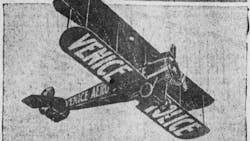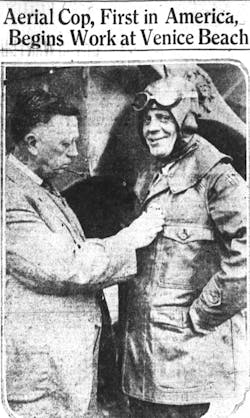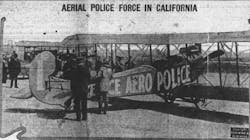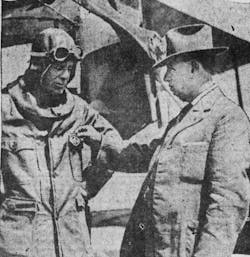How the First Air Patrolman Took Flight
The first known use of an airplane for law enforcement purposes was in Miami, Florida in 1914. A woman staying at the Royal Palm Hotel had her diamond brooch stolen. An investigation revealed that the thief was a former employee of the hotel. He boarded a steamboat that was heading for the Bahamas. Charles Witmer was the pilot for Chicago businessman Harold McCormick, who owned his own plane. Detectives approached Witmer for assistance in apprehending the suspect.
McCormick, an aviation enthusiast, was president of the Aero Club of Chicago. He owned a Curtiss seaplane, the Edith M, named for his 1-year-old daughter who had passed away. With two detectives on board and Witmer piloting, the plane intercepted the ship about 21-one miles off the coast of Florida. The detectives boarded the ship, arrested the suspect, and flew him back to Miami.
It would be 5 years later before law enforcement began to see the value of aviation. During World War I, the U.S. had trained a large number of soldiers to fly airplanes. After the war, many of them wanted to use their newfound training for civilian applications. In April 1919, New York City formed the first air police, although it would be a few months before the unit went live. However, Venice, a suburb of Los Angeles, was about to make national headlines when they hired the first air patrolman to take to the sky. What started off as a proposal made in jest would turn all eyes from the East to the West coast and pave the way for a Swedish immigrant to achieve the American dream.Venice’s first air patrolman, Otto “Swede” Meyerhoffer, was born in 1885 and immigrated from Pites, Sweden, first arriving in Honolulu in 1902. The next year, he settled in Oroville, California. One of his first jobs was as a foreman at the Ekman Stow olive plant. In 1909, he became a naturalized citizen. He acquired an active interest in aviation that would lead him down a path towards becoming the first air patrolman in the U.S.
In 1910, Meyerhoffer invented his own airplane that was very different in design than those that were currently built at the time by the Wright brothers, the Curtiss Aeroplane Company and the Farman Aviation Works. The plane incorporated a number of different features of the monoplane, bi-plane, and tri-plane, which led to a new design, the mono-bi-tri-plane. It was affectionately named “California” after its inventor. The plane was built in San Francisco for $4,000 by the Western Aviation Company. The first successful flight was made on Dec. 21, 1910 in Pleasanton, California.By the end of 1911, Meyerhoffer moved from Oroville to San Francisco to open up an aviation repair shop and created the California Aviation Company that manufactured airplanes and gliders. In 1915, he experienced his first airplane crash when he took 74-year-old Lula Comstock up to celebrate her retirement. After they had reached 1,500 feet off the coast of San Diego, Mrs. Comstock began to have a panic attack and grabbed Meyerhoffer. He tried to break free of her grip and while doing so, lost control of the airplane and flipped it before crashing into the water. They were thrown from the wreckage. Lula Comstock was killed and Meyerhoffer escaped with just a few scratches on his face.
At the outbreak of World War I, Meyerhoffer was drafted into the military. He had previously enlisted in the U.S. Merchant Marines as a boat operator. He was first stationed at Camp Kearny in San Diego (present day Marine Corps Air Station Miramar.) Because of his reputation as a knowledgeable aviation instructor, he was transferred to the aviation school in Riverside (present day March Air Force Reserve Base).
After the war, Meyerhoffer went back to pursue his passion for aviation. He attempted the first transcontinental flight from Santa Barbara, California to Washington, D.C. The 1200-mile flight would include two stops in Deming, New Mexico and Peoria, Illinois. However, the flight had to be abandoned when the plane crashed near Gila, Arizona. Meyerhoffer escaped with minor injuries.
Although New York was in the process of implementing an aviation unit, Venice attempted to be the first in the nation with an active aerial patrolman. It started off as a joke. City Trustee Edward Gerety, at a board meeting, made a proposal to create an aerial police unit. He believed that an aerial unit had benefits such as settling disputes of fishermen offshore, preventing smuggling, helping to apprehend speeding motorists, and capturing criminals who flee from the police. He was surprised when his fellow board members voted unanimously to create the new position.Meyerhoffer, who ran a nearby aviation school, had no law enforcement experience. He was commissioned as a special police officer within the Venice Police Department. He would wear the regulation uniform like any other department member and be assigned a regular patrol shift.
His installation ceremony, April 3, 1919, was an historic event that would be heralded around the world. Hundreds of people had gathered to watch Meyerhoffer become the first aerial patrolman in the U.S. Dignitaries included the entire Venice City Council, the mayor, the chief of police, along with many other politicians and chiefs of police from nearby Santa Monica, Santa Barbara, Los Angeles and cities around the state. The Venice of America Band provided the entertainment and motion picture operators and photographers were on hand to record the historic event.
The ceremony began with the swearing-in by Mayor A.E. Coles. A special gold badge had been designed specifically for him. Along with the badge, he was given a pair of handcuffs and a revolver. Meyerhoffer, a Swedish immigrant, officially became the first aerial police officer in the U.S.
Once he became official, the crowd was given a demo as to how the new airplane would be used. After the Chief of Police, T.H. Griffin, refused to go up in the plane, a citizen in the crowd accepted the invitation to be the “first prisoner.” Meyerhoffer took the “prisoner” and Officer Earl Stukey up to an altitude of 3000 feet before landing in front of the crowd. Once on the ground, Officer Stukey transferred the “prisoner” to the patrol wagon. Meyerhoffer made it clear that no prisoner would be handcuffed while in the plane. The handcuffs would only be used during transport to the patrol wagon.
The decision to create an aviation unit was made easier when Meyerhoffer voluntarily donated the use of his plane instead of the city having to purchase one. The 8-cylinder bi-plane was painted green with the words “Venice Police'' painted in large white letters on the wings so that it would be easily identifiable from anyone on the ground.
The first major catastrophe involving the airplane occurred exactly two weeks after his swearing-in. Meyerhoffer’s assistant was flying the plane with a passenger when it experienced engine trouble and plunged 600 feet to the ground crashing in an intersection in downtown Venice. Both occupants were killed on impact. Another plane was commissioned into service to replace it.
The vision for the plane as a “crime fighting” vehicle never really materialized. Instead, it seemed to be used more for publicity. People could come to the airfield and pay to take a ride in the police plane. One of his first assignments after becoming an officer was to take the Count and Countess Casella Tamburini of Paris over the ocean and the Santa Monica mountains. Another time, he took a couple on a flight for their honeymoon.
A little more than a year after making history as the first aerial policeman, Otto Meyerhoffer was killed in McArthur, California. It isn’t clear when he left the Venice Police Department, but at the time of his death he was employed by the Moffett and Hunt Aircraft Company in Willows, California. While he was cranking the engine of the airplane by turning the propeller, he lost his balance and fell into the blades.
The Venice Aerial Unit didn’t die with Meyerhoffer though. In 1922, Venice expanded the unit to include three aviators. At the time the city was one of only four in the U.S. with a full-time aviation unit. The expanded unit was short-lived though as the city sold the airfield to real estate developers in 1923. By 1925, the city of Venice had become incorporated into Los Angeles.
Meyerhoffer was only 35 years old when he died but he had obtained his American Dream. An immigrant to the U.S. at the age of seventeen, he pursued his passion for aviation. Starting with inventing his own airplane, he took part in the first-ever aviation meet in San Francisco in 1911. In 1915, he set the Pacific Coast altitude record of 15,000 feet. He served the US during the war, and he demonstrated that hard work and determination pays off.
About the Author
Robert Bowling is a retired police officer from Fishers (IN) and Durham (NC) police departments. He has served in a variety of roles to include, Field Training Officer, Honor Guard, Evidence Technician, Traffic Crash Reconstructionist, Hostage Negotiator, School Resource Officer, and Crisis Intervention Stress Management team member. His true passion is history and he became the first historian and curator for the Fishers Police Department.
After retirement, he has continued his passion for history focusing on law enforcement and fallen officers. He is an historical researcher for the Officer Down Memorial Page. He is the author of the book Wicked Fishers and serves on the boards of a few historical organizations. He currently teaches Criminal Justice for a local high school.
About the Author

Robert Bowling
Robert Bowling is a retired police officer from Fishers (IN) and Durham (NC) police departments. In retirement, he has continued his passion to honor fallen officers. He is an Ambassador for the National Law Enforcement Memorial, as well as an historical researcher for the Officer Down Memorial Page. He also has a passion for history, focusing primarily on law enforcement history. He is a member of the Police History Society and is the author of the book Wicked Fishers. He currently teaches Criminal Justice for a local high school.




